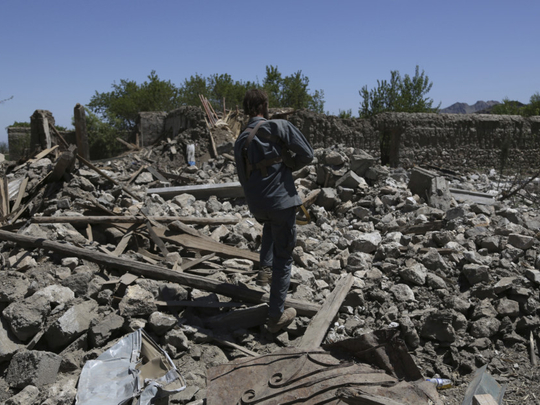
The United States has dropped its largest non-nuclear weapon ever used in combat against Daesh (the self-proclaimed Islamic State of Iraq and the Levant) targets in Afghanistan. But why drop such a gargantuan bomb in the first place? No one can have any sympathy for Daesh and its murderous offshoots, but you don’t need to be a military expert to suspect something strange might be going on here.
Since the stated objective of the US was to destroy underground tunnels, wouldn’t the so-called bunker buster bombs, which can also be huge and dig deep into the earth, serve the aims of this mission just as well, if not better?
Look to the history of colonial warfare for the answer. The lands of the colonised have always served as the western world’s laboratory for the newest and worst weapons of war. Bombs may have been with us since the invention of gunpowder, but the phenomenon of aerial warfare is only as old as November 1, 1911, when Libya became the first country to suffer a bombardment from the sky.
Late to the colonial scramble for Africa, Italy coveted Libya, then a province of the failing Ottoman Empire. In 1911, the Italians invaded the north African territory and that November, Lieutenant Giulio Gavotti flew over Ain Zara, just east of Tripoli. Unbeknown to his superiors, Gavotti tossed four 1.5kg grenades out of his window, pulling the pins with his teeth, and watching them explode on the oasis town below. He later wrote that he was “really pleased with the result”.
Just like today, the press went crazy with the news. The innovation of aerial warfare was mind blowing. Gavotti was lauded as a true Italian hero, although Europe’s professional warriors initially thought otherwise. They considered the act beneath the rules of civilised combat. Their contempt didn’t last long, and a new era of aerial warfare, especially against “uncivilised” peoples, began.
Death from the sky
In 1920, Britain took charge of Iraq, and a popular revolt quickly erupted. The Royal Air Force responded with a new strategy they called “control without occupation”. The thinking was that there would be no need for large and costly contingents of soldiers on the ground if one could simply bomb the local population into submission from the sky. And bomb they did. For days, weeks, and months on end. Churchill, who in 1919 had penned a memo stating that he was “strongly in favour of using poisoned gas against uncivilised tribes”, even pushed Air Marshal Trenchard in 1920 to “proceed with the experimental work on gas bombs, especially mustard gas, which would inflict punishment upon recalcitrant natives without inflicting grave injury upon them”.
Historians now believe there wasn’t enough mustard gas to go around, so large-scale conventional bombing was left to achieve Britain’s desired result in Iraq
The US is not immune to such military opportunism either. The US fired its first depleted uranium munitions during the 1991 Gulf war. A total of 320 tons (290,300 kgs) landed in Iraq in that war, and depleted uranium has a half-life of 4.5 billion years, as old as our solar system now is. The results have been spectacularly terrible throughout Iraq, with birth defects and cancer rates disturbingly elevated throughout the country.
Russians proud
The Russian military has exploited its campaign assisting the Al Assad regime in Syria to test out 162 new weapons systems, including new cruise missiles and long-range bombers. It would seem the Russians are very proud of their new weapons. Defence Minister Sergei Shoigu used the occasion of Vladimir Putin’s 63rd birthday to announce that Russia had fired cruise missiles at targets in Syria from the Caspian Sea, some 900 miles (1,448km) away.
Look at the countries mentioned thus far — Libya, Iraq, Syria, and Afghanistan. South-east Asia of course also suffered terribly when it was the West’s main laboratory of death and destruction, but this list of countries should give us a sense of history regarding our current conflicts, along with some much-needed humility about the success of bombing people into submission.
This brings us to the GBU-43/B, a 22,600-pound (10,251 kilogram) bomb that is known as a MOAB, officially standing for Massive Ordinance Air Blast but unofficially the Mother of All Bombs. Developed for the 2003 Iraq war, each GBU-43/B reportedly costs $16 million (Dh58.7 million). The bomb, which explodes before impact and with a reported blast radius as large as a mile in diameter, is the second-largest non-nuclear weapon in the American arsenal. It has never been used before. Until now.
Once again, the territory inhabited by the “uncivilised” has been shelled so the West can try out its new lethal toys. Forgotten in all of this is that bombs, especially ones this size, don’t affect only people. Munitions may be aimed at enemies, but an enormous bomb such as this kills plant life massively as well. When such a bomb detonates, a percussive blast destroys everything in it fatal path, shattering the insides of humans and animals alike.
The air is literally sucked out of the atmosphere to feed the jealous fire created by its explosion. The aim of such a bomb is to kill enemies but at what consequence to our earth? There is something narcissistic to think that bombs of this enormity are an attack on humanity alone. In fact, they are an assault on all forms of life.
— Guardian News & Media Ltd
Moustafa Bayoumi is an award-winning writer, and associate professor of English at Brooklyn College, City University of New York.








